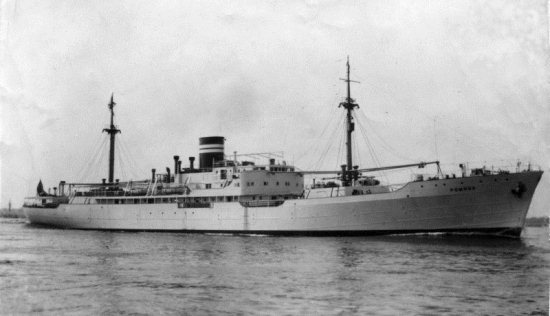Empire Merchant
British Motor merchant

Empire Merchant under her former name Pomona. Photo courtesy of Ben Smith
| Name | Empire Merchant | ||
| Type: | Motor merchant | ||
| Tonnage | 4,864 tons | ||
| Completed | 1938 - Deutsche Werft AG, Betrieb Finkenwärder, Hamburg | ||
| Owner | Kaye, Son & Co Ltd, London | ||
| Homeport | London | ||
| Date of attack | 16 Aug 1940 | Nationality: | |
| Fate | Sunk by U-100 (Joachim Schepke) | ||
| Position | 55° 21'N, 13° 40'W - Grid AM 4611 | ||
| Complement | 56 (7 dead and 49 survivors). | ||
| Convoy | |||
| Route | Avonmouth (14 Aug) - Kingston, Jamaica | ||
| Cargo | 200 tons of general cargo and mail | ||
| History | Completed in July 1938 as German Pomona for F. Laeisz, Hamburg. On 3 Sep 1939, seized by Britain in the London docks after an unsuccessful attempt of the crew to set her on fire and was renamed Empire Merchant by Ministry of War Transport (MoWT). | ||
| Notes on event | At 09.27 hours on 16 Aug 1940 the unescorted Empire Merchant (Master Benjamin Walton Smith) was hit on the starboard side by two G7e torpedoes from U-100 while steaming on a zigzag course at 16 knots about 186 miles west of Bloody Foreland. The first torpedo struck in the empty #4 hold and the second slightly more forward. The flooding of the after holds caused the ship to settle by the stern with an immediate list of 5° to starboard. The crew of 45, two gunners (the ship was armed with one 4in and one 12pdr guns) and nine passengers, including women and children, immediately began to abandon ship in both starboard lifeboats, while the master and a wireless operator remained behind to send a distress signal and then jumped overboard. Two sailors had managed to launch one of the port lifeboats and they picked up a crew member that had inadvertently been left behind. The ship slowly turned over to starboard and sank vertically by the stern about 15 minutes after being torpedoed in 55°23N/13°24W. Six crew members and one gunner were lost. The survivors spotted the U-boat surfacing nearby and wondered why they were not questioned by the Germans. They apparently did not observe how U-100 suddenly dived again due to a handling error and Schepke, standing alone on the bridge, was forced to shut the conning tower hatch from outside. He clung to the periscope block until the boat surfaced again. Schepke assumed in the war diary that it must have been a funny sight for the survivors in the lifeboats to see a German U-boat commander in such an embarrassing situation. The BdU was not amused. Some survivors were transferred to the almost empty boat and about two hours later a Sunderland flying boat appeared, which dropped its depth charges and then tried to rescue the women and children despite a heavy swell but broke its starboard float in the landing attempt and had to leave them. The boats then set sail towards Ireland and were separated during the second night. In the early morning on 18 August, the boat in charge of the second officer was spotted by the Yugoslavian steam merchant Supetar, which picked up its 21 occupants, including a woman and six children and transferred them to an armed trawler in the Irish Sea as the ship was en route to Buenos Aires. They were eventually landed at Moville during the afternoon. In the morning on 18 August, the eleven men in the boat of the chief officer were picked up by HMS Warwick (D 25) (LtCdr M.A.G. Child, RN), escorting convoy OB-199 and were landed at Liverpool on 23 August. The 17 people in the boat of the master observed aircraft on several occasions and even saw a convoy but were not seen until an aircraft spotted them after having sailed 168 miles during the afternoon on 18 August and alerted the nearby HMS Salvonia (W 43) (Lt G.M.M. Robinson, RNR), which picked them up and landed them at Greenock. | ||
| On board | We have details of 14 people who were on board. | ||
If you can help us with any additional information on this vessel then please contact us.
